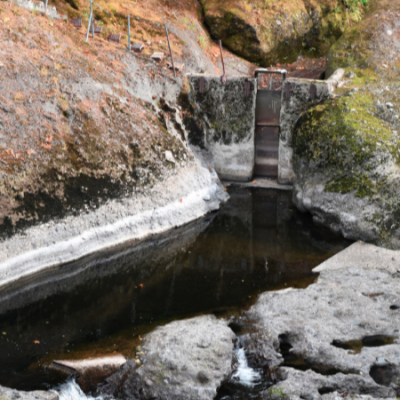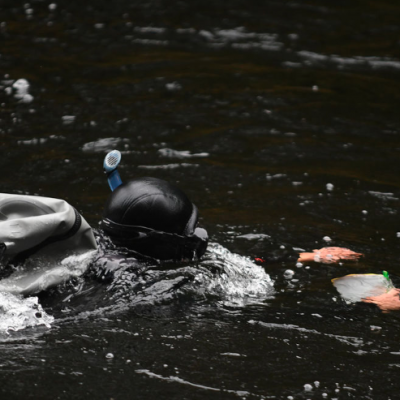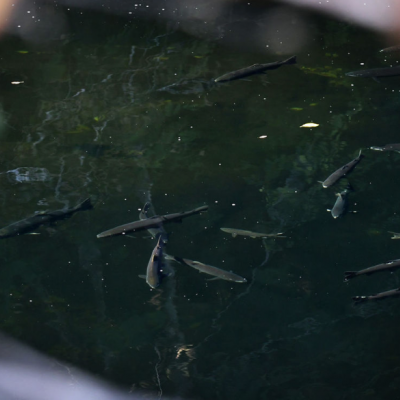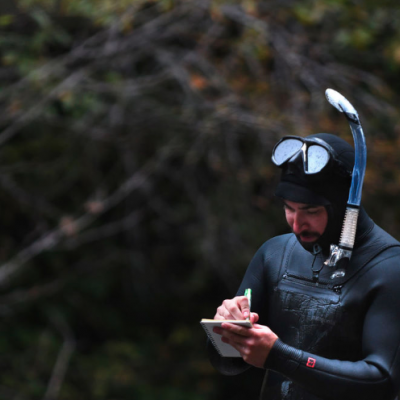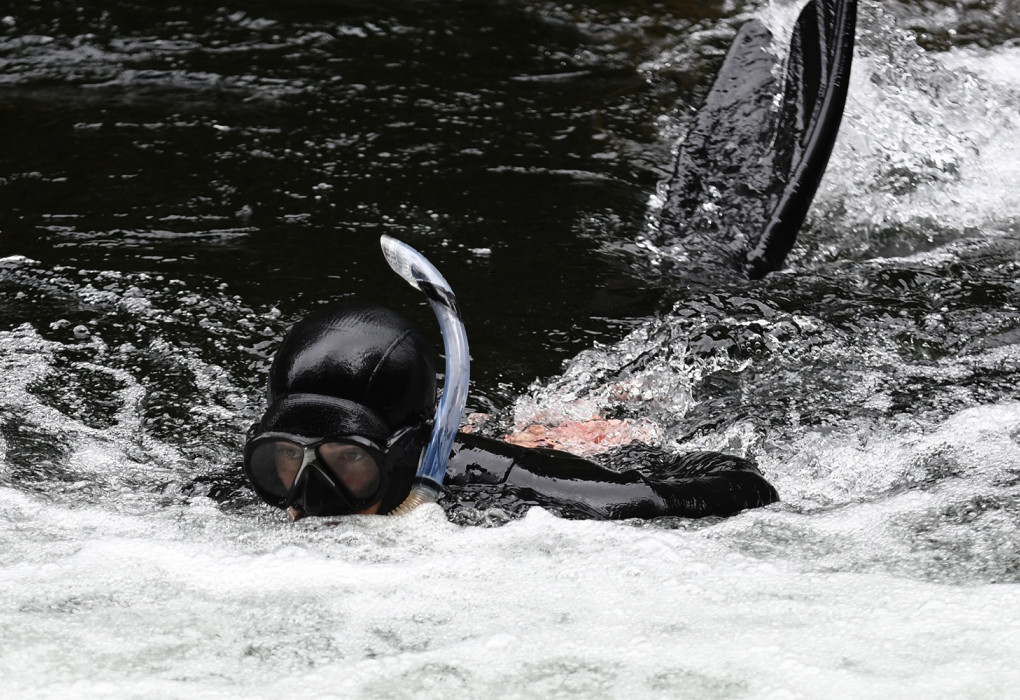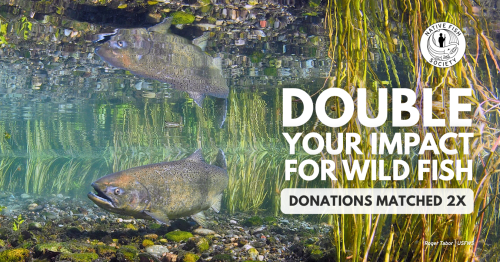Keeping it Wild
SILETZ — Francis “Doc” Reedy raises a pair of binoculars to his eyes and scans the large pool of still water where the north and south forks of the Siletz River come together. It doesn’t take him long to spot what he’s looking for.
“Wow!” he says. “That’s a huge steelhead!”
The Siletz, which has its source near the border of Polk and Lincoln counties and flows 67 miles to the sea near Lincoln City, is well known in fishing circles for its steelhead, an oceangoing variant of rainbow trout that, like salmon, return to their home streams to spawn. Anglers on the river have reported landing steelhead more than 30 inches long and weighing well over 20 pounds.
While there are plenty of good fishing rivers in Oregon, the Siletz is unique in one regard: It is home to the only wild summer steelhead run that originates in the Coast Range. For dedicated anglers like Reedy, president of the Corvallis-based Bluebacks chapter of Trout Unlimited, that’s a distinction worth defending.
The river’s upper reaches have been managed as a sanctuary for wild summer steelhead since the mid-1990s, but in recent years hatchery fish have been finding their way past the barriers designed to keep them out, posing a threat to the genetic purity — and ongoing viability — of the region’s only summer run.
“The wild summer steelhead runs, they have been in peril for some years,” said Reedy, a semiretired large-animal veterinarian who lives in North Albany. “We just feel that’s an important resource for the area and the whole state.”
As recently as the early 1970s, state wildlife managers counted an annual average of 624 wild summer steelhead returning to the upper Siletz. By the early ’90s, however, the annual returns had plummeted to less than 100, with fewer than 50 counted in some years.
Starting in 1994, the Oregon Department of Fish and Wildlife implemented a recovery plan aimed at giving the wild summer steelhead a fighting chance to survive.
The goal was to keep competing fish out of the upper Siletz by stopping them at Valsetz Falls, a 40-foot cascade that drops through a boulder-choked gorge not far from the onetime timber company town of the same name. While high winter flows generally keep most fish out of the upper basin, some winter-migrating steelhead and salmon were making their way past the falls during the summer, along with hatchery-produced steelhead.
“The thought was there was so much competition between winter and summer steelhead that the summer steelhead were just not doing that well,” said John Spangler, a fish biologist with ODFW.
To keep the winter-run steelhead (which spawn in the lower river) downstream, the state agency used a fish ladder and small dam at the falls.
When river levels begin to drop in the summer, ODFW crews place boards across an opening in the dam to divert more water through the ladder, making it a more attractive route for fish working their way upstream. Fish coming up the ladder are caught in a trap, which is checked regularly by ODFW personnel. Winter-run fish are trucked back to the lower river, while the wild summer steelhead are released above the dam to continue their journey to their spawning grounds in the basin’s upper reaches.
At first, hatcheries played a part in the recovery program, with the state releasing 80,000 smolts a year into the Siletz system. That number has since been reduced to 50,000, and the state stopped allowing hatchery steelhead to pass the dam at Valsetz Falls in 2002.
Today, no fishing is allowed above the falls. Anglers working the lower river can keep up to two fin-clipped hatchery steelhead per day, but fishing for wild summer steelies is catch-and-release only.
Any wild winter steelhead or salmon found in the trap are trucked back to the lower river for release, while hatchery fish are either delivered to area food banks, donated to high school biology programs for dissection or killed and placed in the river, where the nutrients they brought back from the sea can be recycled.
“We know hatchery fish pose a risk to wild stocks,” Spangler said. “(We’re) trying to find this balance between conservation of wild stocks and still having this opportunity for harvest of hatchery fish.”
The wild summer steelhead run seems to have responded well to that approach, according to Spangler, with a much higher annual return.
“Now we’re getting on average over 500 fish,” he said. “When we stopped those winter-migrating fish, it really zoomed back up.”
The hatchery threat
Apparently, however, some hatchery steelhead didn’t get the memo.
A few years ago, members of the Bluebacks monitoring the area above the falls started noticing clipped-fin steelhead in the upper Siletz. In 2014, some of the steelheaders donned wetsuits and snorkeling gear to do an in-stream count.
“We saw quite a few hatchery fish, and that alarmed us,” Reedy said.
Last year they commissioned a snorkel survey by professional fish biologists that confirmed their fears, finding that hatchery fish made up roughly 20 percent of the total steelhead population above the falls.
According to Reedy, that’s a problem for several reasons.
For one thing, hatchery steelhead compete with their wild counterparts for food. They can also create crowded conditions that facilitate the spread of disease.
In addition, hatchery fish sometimes prey on wild steelhead. But a bigger problem comes from the introduction of large numbers of hatchery smolts into the river at one time, which can act like a magnet for predators such as seabirds, herons, otters and mergansers that feed on wild and human-raised fish alike.
“When the hatchery fish come through,” Reedy said, “the predators just go nuts.”
Another concern has to do with DNA. Researchers have suspected for years that hatchery fish are less genetically fit to survive in the wild than native fish, a theory that appears to have been corroborated by an ODFW-Oregon State University study published in February that found hatchery steelhead differed from wild fish in more than 700 genes after just a single generation.
Specifically, the study determined that many of those altered genes showed adaptation to highly crowded hatchery conditions. Passing those traits on to the next generation could result in steelhead less suited to survive on their own while watering down the native gene pool.
“My worry is inbreeding,” Reedy said. “If you lose that resiliency and (genetic) diversity, you’re in trouble.”
In response to those concerns, conservation groups such as Trout Unlimited and the Native Fish Society are pushing the notion of establishing wild steelhead sanctuaries.
The state of Washington recently declared the Elwha and Nisqually rivers wild steelhead gene banks, where hatchery-raised fish are to be excluded and other measures taken to protect native steelhead runs. Oregon has taken similar steps in some smaller watersheds such as the Siletz, and U.S. Rep. Peter DeFazio recently introduced legislation to implement steelhead protections in the Steamboat Creek drainage in the North Umpqua River basin.
“We can’t go back to 1950,” said John McMillan, head scientist for Trout Unlimited in the Pacific Northwest. “But we do think there are places that are more special than others, and we think those places deserve special treatment so these fish can be protected.”
Plugging the gap
Those protections may not work, though, if hatchery fish can’t be kept out of wild steelhead spawning areas such as the upper Siletz. After learning of Trout Unlimited’s concerns, ODFW took steps to address the problem at Valsetz Falls.
Spangler thinks the hatchery steelhead found in the upper river got there by swimming up the falls over the last two summers, when the agency neglected to put in the dam boards to divert water into the fish ladder.
“Those weren’t put in, and it allowed more fish to get over the dam,” he said, but added that’s no longer the case.
“We put a lot of effort into keeping hatchery fish out of the upper basin this year,” Spangler said. “The expectation is we should have very few if any hatchery steelhead above the falls.”
To test that theory, McMillan led a snorkel survey of the upper Siletz on Sept. 30. Joining him were two other fish biologists, Nick Chambers of Trout Unlimited and Conrad Gowell of the Native Fish Society. Reedy drove a support vehicle.
Armed with wetsuits, snorkels and diving masks, the three scientists surveyed 11 miles of river. They moved methodically from pool to pool, counting every steelhead they could find and keeping a wary eye out for the telltale clipped adipose fin that marks a hatchery-bred fish.
They didn’t expect to spot every summer-run steelhead that made it past the falls this year. Instead, they wanted to see whether the proportion of hatchery fish had gone up or down from last year’s 20 percent.
The results were encouraging. The final tally: 147 steelhead. Of that number, only nine, or 6.1 percent, were hatchery products.
“That’s probably acceptable,” said Chambers, an organizer for Trout Unlimited’s Wild Steelhead Initiative. “We’d like to see that at zero, but under the circumstances … that’s certainly much better than last year.”
A delicate balance
Of course, hatchery fish are far from the only threat to the Siletz River’s one-of-a-kind wild summer steelhead run.
As in virtually every other river system in the United States, fish in the Siletz basin are under pressure from a host of human activities. Those include water withdrawals for residential, industrial and agricultural use; loss of forest cover to various types of development; the possibility of dam construction, such as the proposed Polk County reservoir project at the old Valsetz town site; and logging activity, which can lead to increased sediment loading, higher water temperatures, herbicide runoff, higher water volumes during flood events and loss of downed wood needed to supply nutrients, create channel complexity and provide habitat.
Logging is an especially sensitive issue in the Siletz basin, where about 75 percent of the total area is privately owned industrial timberland. The remaining 25 percent or so is held by the Bureau of Land Management, including the Valley of the Giants, a 51-acre old-growth preserve, and Boulder Creek, a key spawning stream for summer-run steelhead.
“This is the most deforested watershed in Oregon — 42 percent of the Siletz basin has been clearcut in the last 12 years,” Reedy said. “And the problem is they’re not happy with that 42 percent. They also want the BLM lands, to cut that.”
The federal agency is currently evaluating a new management plan for Western Oregon that Reedy fears could lead to intensive logging in the Boulder Creek drainage.
“That’s a great steelhead stream,” Reedy said. “In the back of my mind, I feel like that’s what kept the steelhead alive for a lot of years.”
If even more of the Siletz basin is logged, the wild steelhead supporters argue, it could upset the delicate balance that has allowed the summer run to bounce back, reversing the progress it has made so far. That could lead to a listing as threatened or endangered, triggering a cascade of legal restrictions on logging and other activities under the federal Endangered Species Act — something nobody seems to want.
“Our message at Trout Unlimited is that when you have a lot of uncertainty, you need to manage on the side of caution,” McMillan said. “Because these fish are really valuable, not only to fishermen but in terms of how we manage these lands.”
Or, as Reedy put it: “Part of what we’re doing is trying to preserve the fish, but it’s also to keep them from being listed as an endangered species.”
Dual refuge
Spangler argues that ODFW’s management strategy is sound, pointing to the increased wild steelhead returns since the 1990s as evidence.
“I think it’s the best approach we’ve got at this point,” he said. “I’m pretty confident that the recovery plan that was developed is working.”
Despite some reservations about the state’s plan, Reedy hopes it does prove successful in the end.
He made his first visit to the Siletz River in 1972, not long after moving to the region as a recent college graduate from the Midwest. Since then, he’s fished these waters many times. Even when the steelhead aren’t biting, he says, he values his time on the river.
“It’s a unique experience in that respect,” he said. “Even if you don’t see any fish, it’s a beautiful area.”
The Siletz, he adds, is especially precious because of its location in the midst of an industrial logging zone. As an isolated oasis of natural beauty in one of the most heavily logged parts of the Coast Range, Reedy argues, it provides a refuge not only for wild steelhead but also for the outdoor lovers who fish for them.
“It’s nice to have those places, just to get away,” he said. “It’s good for the body, it’s good for the mind and it’s good for the soul.”
